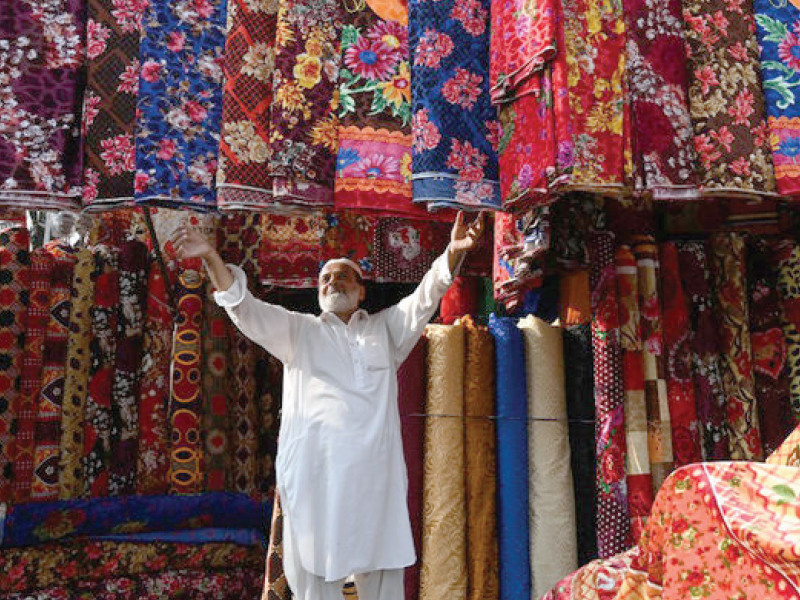
Pakistan’s textile exports marginally increased by 3% and reached $1.3 billion in March 2024 compared to the same month of last year, according to provisional data compiled by the All Pakistan Textile Mills Association (Aptma).
Last year in March, textile manufacturers had exported goods worth $1.26 billion. When compared with exports of $1.41 billion in February 2024, textile shipments registered a slump of around 8% in March 2024.
Earlier, textile exports surged 20% in February compared to shipments of $1.18 billion in the same month of the previous year. However, on a month-on-month basis, textile exports dropped over 3% in February against $1.46 billion in January.
Exports have registered an increase for four consecutive months as compared with last year. Overall, exports of the textile industry have remained stagnant in the first nine months of the current financial year, recording a decline of 0.3%, or $0.04 billion, to $12.44 billion.
Industry officials attribute the decline to a manifold increase in input costs for textile manufacturers, which makes exports uncompetitive in the international market.
The textile sector has already warned the Special Investment Facilitation Council (SIFC) about the likelihood of a further decline in shipments in the absence of financially viable energy supplies.
It pointed out that the lack of a competitive energy source for the industry was a major obstacle in the way of sustaining manufacturing activities and competing internationally.
Exporters enjoyed a regionally competitive energy tariff of 9 cents per kilowatt-hour (kWh) in financial year 2021-22, which resulted in a record growth of 54% in textile and apparel exports, from $12.5 billion in FY20 to $19.3 billion in FY22.
However, the power tariff for export-focused firms was later increased to over 14 cents per kWh, leading to a decline in textile and apparel exports to $16.5 billion in FY23.
Read Textile exports dip again despite yearly growth
The electricity price for industrial consumers has been raised from 14 cents per kWh to approximately 17.5 cents (Rs46) on account of quarterly tariff adjustment, driven by the falling power consumption, and fuel charges adjustment of Rs7.056 per kWh for January 2024.
The power-sector regulator has recently notified a hike of Rs2.7492 per kWh in the uniform tariff that burdens consumers with an additional cost of Rs85.2 billion for the second quarter of FY24.
The textile industry fears that the recent increase in power tariff will have a further negative impact on exports owing to high input costs.
The electricity tariff for Pakistan’s textile industry is more than twice the average tariff paid by competing companies in regional economies such as Bangladesh (8.6 cents/kWh), India (average 10.3 cents/kWh and 6 cents/kWh for textile and apparel firms in Maharashtra) and Vietnam (7.2 cents/kWh).
Furthermore, gas prices for industrial consumers have been jacked up to Rs2,750 per million British thermal units (mmBtu), an increase of 223% since January 2023. This has dented the financial viability of the captive power generating plants of industrial units, which comprise a significant part of the industry.
Consequently, textile and apparel exports have stagnated around $1.4 billion per month, which is $600 million below the installed capacity of $2 billion per month.
Textile millers’ body Aptma has underlined the need for the government to adopt the Competitive Trading Bilateral Contracts Market (CTBCM) model to enable business-to-business (B2B) electricity supply contracts with the use-of-system/ wheeling charge of 1-1.5 cents per kWh, excluding cross-subsidies and stranded costs.
The demand is aimed at enabling the industry to procure green energy at competitive end-user prices through captive power generation from geothermal plants in the depleted oil fields, hybrid solar-wind plants and other green energy producers.
Additionally, the textile industry has called for increasing the ceiling on solar net-metering for industrial consumers from 1 megawatt to 5MW in a bid to facilitate the transition towards net-zero emissions by adding over 3,000MW of clean energy at the point of consumption, with no investment or guarantee from the government.
Published in The Express Tribune, April 3rd, 2024.
Like Business on Facebook, follow @TribuneBiz on Twitter to stay informed and join in the conversation.


1730884134-0/BeFunky-collage-(26)1730884134-0-165x106.webp)

1730981853-0/BeFunky-collage-(30)1730981853-0-165x106.webp)



1730963708-0/Express-Tribune-Web-(27)1730963708-0-270x192.webp)












COMMENTS
Comments are moderated and generally will be posted if they are on-topic and not abusive.
For more information, please see our Comments FAQ